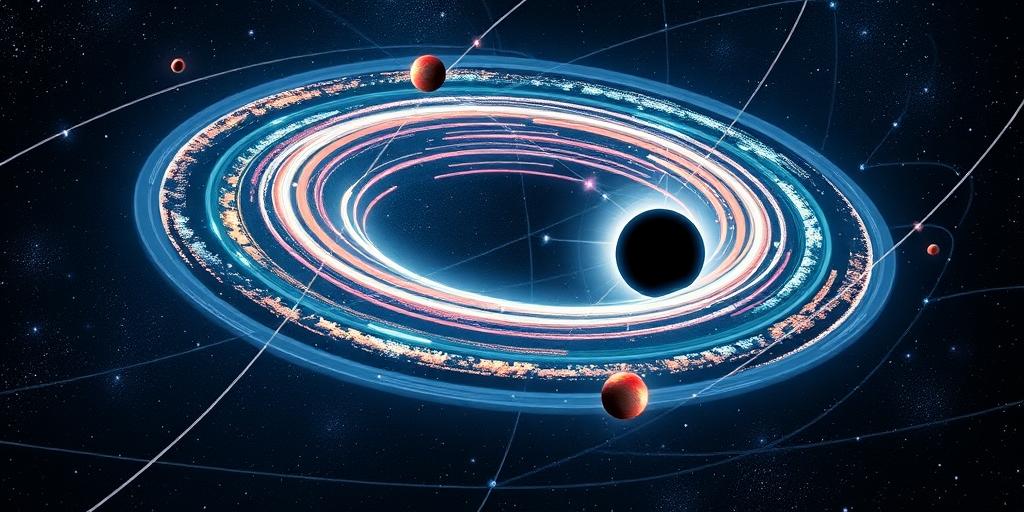Understanding General Relativity: Einstein's Universe
General relativity, formulated by Albert Einstein between 1907 and 1915, is a theory of gravitation that describes the universe at its largest scales. It revolutionized our understanding of gravity, space, and time, moving beyond Newton's classical description to a more nuanced and accurate model.
The Core Concepts
At its heart, general relativity posits that gravity is not merely a force acting between masses, but rather a curvature in the fabric of spacetime caused by the presence of mass and energy. Imagine spacetime as a vast, interconnected sheet. When an object with mass is placed on this sheet, it creates a 'dent,' causing other objects to move toward it. This 'movement' is what we perceive as gravity.
- Spacetime: A four-dimensional continuum that combines the three dimensions of space with the dimension of time.
- Curvature: The distortion of spacetime caused by mass and energy. The more massive an object, the greater the curvature.
- Geodesics: The paths that objects follow through spacetime. In the absence of other forces, objects follow the shortest path, or geodesic, which appears curved due to the curvature of spacetime.
Key Predictions and Evidence
General relativity makes several key predictions, many of which have been confirmed through observation and experiment:
- Bending of Light: Massive objects bend the path of light. This was famously observed during a solar eclipse in 1919, providing early evidence for general relativity.
- Gravitational Time Dilation: Time passes slower in stronger gravitational fields. This effect is crucial for the accuracy of GPS satellites, which experience slightly different gravitational fields compared to Earth's surface.
- Gravitational Waves: Accelerating masses create ripples in spacetime, known as gravitational waves. These were directly detected for the first time in 2015 by the Laser Interferometer Gravitational-Wave Observatory (LIGO).
- Black Holes: Regions of spacetime where gravity is so strong that nothing, not even light, can escape. Black holes are a direct consequence of general relativity and have been observed through their gravitational effects on surrounding matter and light.
How General Relativity Differs from Newtonian Gravity
While Newtonian gravity is a good approximation in many everyday situations, it breaks down in strong gravitational fields or at very high speeds. General relativity provides a more accurate description of gravity under these conditions.
| Feature | Newtonian Gravity | General Relativity | | :------------------ | :---------------------------------------------- | :------------------------------------------------------------ | | Nature of Gravity | Force acting between masses | Curvature of spacetime | | Speed of Gravity | Instantaneous | Limited by the speed of light | | Applicability | Works well in weak gravitational fields | Accurate in both weak and strong gravitational fields | | Description of Space and Time | Absolute and independent | Relative and interconnected |
Implications and Applications
General relativity is not just an abstract theoretical concept; it has practical implications and applications in various fields:
- Cosmology: General relativity is the foundation of modern cosmology, providing the framework for understanding the evolution of the universe, the Big Bang, and the formation of galaxies.
- Astrophysics: It is essential for understanding the behavior of black holes, neutron stars, and other compact objects.
- Satellite Navigation: As mentioned earlier, gravitational time dilation must be accounted for in GPS systems to ensure accurate positioning.
- Fundamental Physics: General relativity continues to be a crucial area of research as scientists attempt to reconcile it with quantum mechanics, leading to theories of quantum gravity.
Challenges and Future Directions
Despite its successes, general relativity is not the final word on gravity. One of the biggest challenges is reconciling it with quantum mechanics, the theory that governs the behavior of matter at the smallest scales. The search for a theory of quantum gravity, such as string theory or loop quantum gravity, is one of the most exciting frontiers in modern physics. Additionally, the nature of dark matter and dark energy, which make up the majority of the universe's mass-energy content, remains a mystery that requires further investigation within the framework of general relativity.
Conclusion
General relativity has profoundly transformed our understanding of gravity and the universe. From predicting the bending of light to explaining the existence of black holes, its predictions have been repeatedly confirmed, solidifying its place as one of the cornerstones of modern physics. As we continue to probe the cosmos and explore the fundamental laws of nature, general relativity will undoubtedly remain a vital tool and a source of inspiration for future generations of scientists.









